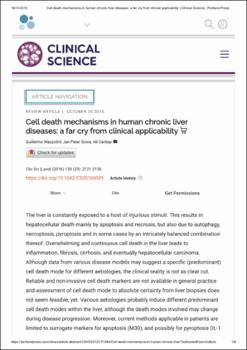Cell Death Mechanisms in Human Chronic Liver Diseases: A Far Cry From Clinical Applicability

View/
Date
2016-10-20Author
Mazzolini, Guillermo.
Sowa, Jan-Peter.
Canbay, Ali.
Metadata
Show full item recordAbstract
The liver is constantly exposed to a host of injurious stimuli. This results in hepatocellular death mainly by apoptosis and necrosis, but also due to autophagy, necroptosis, pyroptosis and in some cases by an intricately balanced combination thereof. Overwhelming and continuous cell death in the liver leads to inflammation, fibrosis, cirrhosis, and eventually hepatocellular carcinoma. Although data from various disease models may suggest a specific (predominant) cell death mode for different aetiologies, the clinical reality is not as clear cut. Reliable and non-invasive cell death markers are not available in general practice and assessment of cell death mode to absolute certainty from liver biopsies does not seem feasible, yet. Various aetiologies probably induce different predominant cell death modes within the liver, although the death modes involved may change during disease progression. Moreover, current methods applicable in patients are limited to surrogate markers for apoptosis (M30), and possibly for pyroptosis (IL-1 family) and necro(pto)sis (HMGB1). Although markers for some death modes are not available at all (autophagy), others may not be specific for a cell death mode or might not always definitely indicate dying cells. Physicians need to take care in asserting the presence of cell death. Still the serum-derived markers are valuable tools to assess severity of chronic liver diseases. This review gives a short overview of known hepatocellular cell death modes in various aetiologies of chronic liver disease. Also the limitations of current knowledge in human settings and utilization of surrogate markers for disease assessment are summarized.

